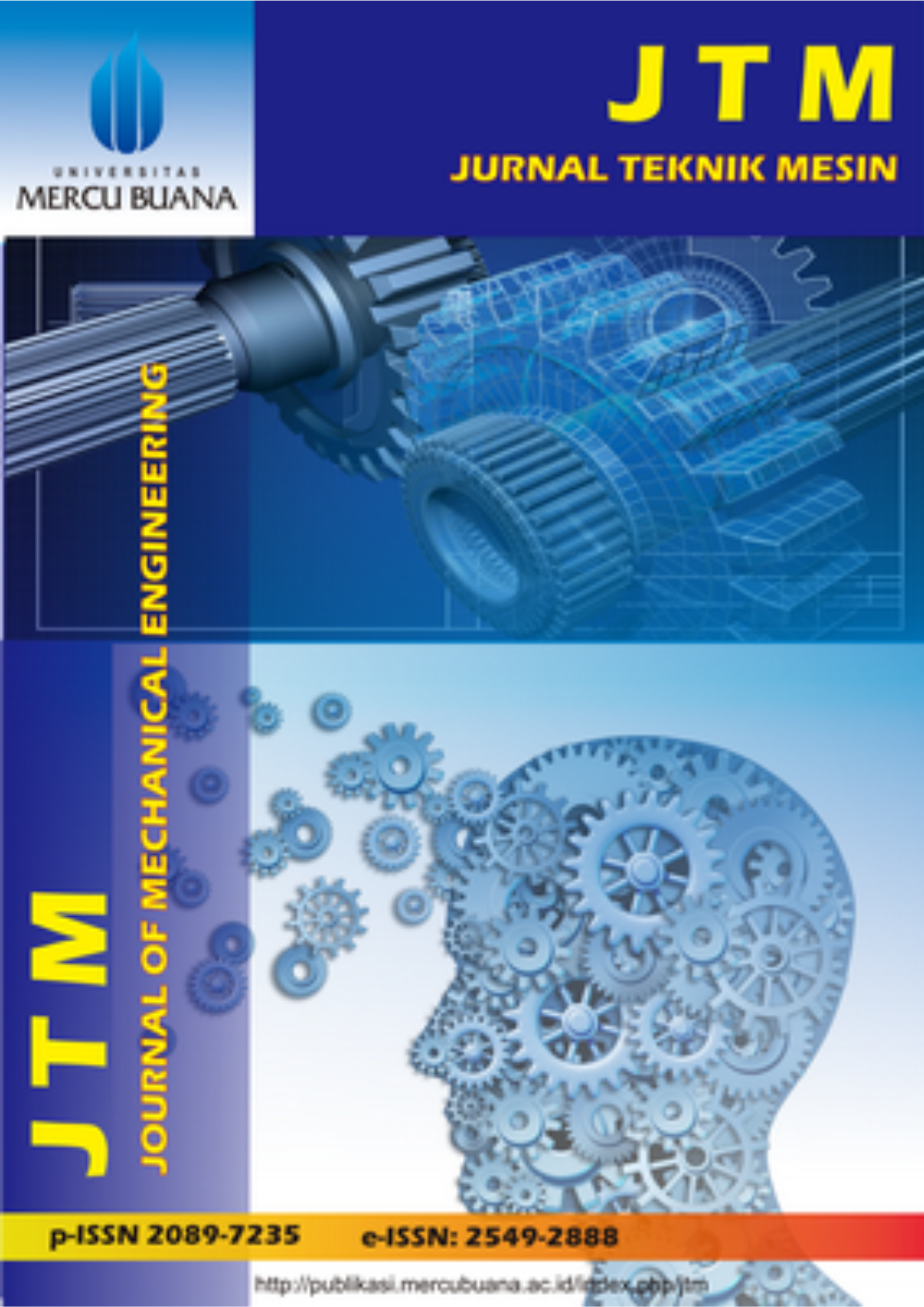Effect of Coconut Shell Powder and MgO-SiO₂ Composite as Flux on Fume Emission, Strength, Hardness, and Microstructure in SMAW Welds : A review
Abstract
Keywords
Full Text:
PDFReferences
. Ahmad, R., Setiawan, D., & Hidayat, S. (2021). Utilization of coconut shell powder as filler in polymer composites. Materials Today: Proceedings, 47, 3265–3270.
. Dewi, K., Ramadhani, I., & Suryani, N. (2024). Pemanfaatan tempurung kelapa sebagai bahan pengisi dalam mortar ringan. Jurnal Teknik Sipil Nusantara, 22(1), 89–95.
. Dwi, A., Fauzan, R., & Jatmiko, H. (2021). Analisis termal serbuk tempurung kelapa sebagai aditif pembakaran biomassa. Jurnal Energi dan Pembakaran, 10(2), 34–42.
. Firdaus, A., Lestari, A., & Yusuf, M. (2023). Studi penggunaan serbuk tempurung kelapa pada pembuatan briket ramah lingkungan. Jurnal Energi Terbarukan, 11(1), 33–40.
. Gunawan, T., Wahyudi, A., & Pramono, H. (2023). Studi penggunaan tempurung kelapa sebagai penguat dalam komposit polyester. Jurnal Rekayasa Material, 12(2), 98–104.
. Ilham, F., Hadi, A., & Rina, S. (2021). Pemanfaatan serbuk tempurung kelapa untuk produksi biokomposit dengan matriks PLA. Jurnal Polimer Indonesia, 9(2), 101–108.
. Khairunnisa, N., Zain, R., & Fitriani, R. (2021). Coconut shell powder reinforced with resin matrix in particleboard production. BioResources, 16(2), 4123–4136.
. Lestari, N., Ramli, A., & Hasan, F. (2023). Pengaruh variasi serbuk tempurung kelapa terhadap kuat tarik komposit polyester. Jurnal Material dan Teknologi, 7(1), 59–66.
. Maheswari, S., Banu, H., & Narayanan, V. (2022). Green composites using coconut shell powder and jute fiber. Materials Today: Proceedings, 60, 1704–1710.
. Mahmud, M., Arifin, A., & Dewi, A. (2023). Pemanfaatan serbuk tempurung kelapa dalam pembuatan media tanam organik. Jurnal Agroindustri Tropika, 9(1), 22–28.
. Nabila, F., Rosyid, A., & Hidayah, M. (2021). Pemanfaatan serbuk tempurung kelapa dalam produksi pakan ternak fermentasi. Jurnal Ilmu Ternak, 21(3), 111–118.
. Nurhalimah, S., Rakhmat, A., & Luthfi, R. (2024). Potensi serbuk tempurung kelapa sebagai bahan baku karbon aktif dalam penyaring air. Jurnal Teknologi Lingkungan, 25(1), 50–58.
. Prasetya, D., Nugroho, T., & Syamsudin, M. (2022). Coconut shell powder-based ceramic materials for eco-bricks. Ceramics International, 48(15), 21834–21842.
. Putri, M., Santoso, E., & Fitriyanti, R. (2021). Adsorpsi logam berat menggunakan serbuk tempurung kelapa termodifikasi. Jurnal Kimia Terapan Indonesia, 23(3), 115–122.
. Qadri, M., Yusof, A., & Ibrahim, M. (2021). Activated carbon from coconut shell for dye adsorption: A comparative study. Journal of Environmental Chemical Engineering, 9(5), 105738.
. Ramesh, K., Devi, P., & Babu, D. (2022). Activated carbon from coconut shell for supercapacitor applications. Journal of Energy Storage, 45, 103456.
. Reddy, M. S., Rao, T. N., & Kumar, P. (2021). Performance of coconut shell powder blended cement mortar. Construction and Building Materials, 301, 124089.
. Rohman, A., Taufik, R., & Zulkarnaen, I. (2024). Studi eksperimen penggunaan serbuk tempurung kelapa dalam campuran aspal beton. Jurnal Infrastruktur, 14(2), 109–117.
. Salim, R., Aulia, D., & Hanifah, N. (2022). Pengolahan air limbah domestik dengan arang aktif dari tempurung kelapa. Jurnal Teknik Lingkungan, 28(1), 71–78.
. Santosa, A., Widodo, H., & Saputra, Y. (2023). Pengaruh penambahan serbuk tempurung kelapa terhadap densitas dan kekuatan tekan paving block. Jurnal Sipil & Lingkungan, 19(2), 155–162.
. Saputra, H., Ramadhani, A., & Febrian, T. (2023). Analisis sifat mekanik elektroda las dengan tambahan serbuk tempurung kelapa pada fluks. Jurnal Mekanikal, 15(3), 210–217.
. Sari, D. P., Wahyuni, M., & Susanto, B. (2022). Pemanfaatan serbuk tempurung kelapa sebagai bahan fluks elektroda SMAW. Jurnal Teknik Mesin, 19(1), 45–52.
. Sharma, V., Singh, P., & Kumar, S. (2022). Biodegradable bioplastics from coconut shell powder and starch. Environmental Technology & Innovation, 27, 102366.
. Taufik, M., Yusuf, R., & Hasan, I. (2022). Utilization of coconut shell powder in geopolymer concrete. Case Studies in Construction Materials, 17, e01337.
. Wijaya, H., Setyawan, A., & Lestari, M. (2023). Coconut shell powder as eco-friendly filler in epoxy composites. Journal of Natural Fibers, 20(6), 1155–1167.
. Yadav, R., Jain, S., & Singh, R. (2024). Bio-based epoxy composite reinforced with coconut shell powder. Sustainable Materials and Technologies, 30, e00459.
. Yuliana, L., Dewi, A., & Sari, R. (2022). Karakterisasi arang aktif dari serbuk tempurung kelapa dengan aktivator H₃PO₄. Indonesian Journal of Chemical Research, 19(4), 245–252.
. Zulkarnain, M., Fadli, A., & Dewantara, R. (2024). Efektivitas serbuk tempurung kelapa sebagai adsorben limbah pewarna tekstil. Jurnal Lingkungan dan Pembangunan, 14(1), 77–85.
DOI: http://dx.doi.org/10.22441/jtm.v14i3.36701
Refbacks
- There are currently no refbacks.
Copyright (c) 2025 Jurnal Teknik Mesin (Journal Of Mechanical Engineering)
Jurnal Teknik Mesin (JTM)
Program Studi Teknik Mesin, Fakultas Teknik, Universitas Mercu Buana
Jl. Meruya Selatan No. 01, Kembangan, Jakarta Barat 11650, Indonesia
Email: [email protected]
Telp.: 021-5840815/ 021-5840816 (Hunting)
Fax.: 021-5871335
JTM is indexed by the following abstracting and indexing services:

This work is licensed under a Creative Commons Attribution-NonCommercial 4.0 International License.






.png)







_(486_x_90_px)_(486_x_190_px)_(486_x_190_px)_(4).png)
_(486_x_90_px)_(486_x_190_px)_(486_x_190_px)_(5).png)
2.png)
.png)